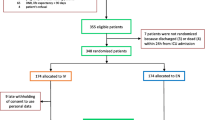Abstract
This retrospective study examines data from 55 patients sedated in a paediatric intensive care unit (PICU) with midazolam. Midazolam sedation was initiated with a bolus of 0.25 mg·kg−1 followed by a continuous infusion of 0.4–4 μg·kg−1·min−1. Physiological and metabolic parameters, infusion rates, duration, and sedation scores were monitored. Midazolam infusions were effective in sedating all the children studied during all or part of their PICU admission. The median duration of sedation was 74h with a range of 4 to 1272h. Haemodynamics were unchanged. Of the patients 46% were effectively alimented by the enteral route, and enteral alimentation was successful in all patients in whom it was attempted. Unassisted ventilation occurred in 44% of the patients during infusion. Oxygen consumption was 28% lower than in the control. Disadvantages of midazolam infusion have included inability to sedate during extracorporeal membrane oxygenation and development of acute tolerance.
Similar content being viewed by others
References
Committee on Drugs, Section on Anesthesiology, American Academy of Pediatrics (1985) Guidelines for the elective use of conscious sedation, deep sedation and general anesthesia in pediatric patients. Pediatrics 76:317–321
Reves JG, Fragen RJ, Vinik R, Greenblatt D (1985) Midazolam: pharmacology and uses. Anesthesiology 62:310–324
Silvasi DL, Rosen DA, Rosen KR (1988) Continuous infusion of midazolam for sedation in the PICU. Anesth Analg 67:286–288
Booker PD, Beechey A, Lloyd-Thomas AR (1986) Sedation of children requiring artificial ventilation using an infusion of midazolam. Br J Anaesth 58:1104–1108
Shapiro JM, Westphal LM, White PF, Sladen RN, Rosenthal MH (1986) Midazolam infusion for sedation in the intensive care unit: effect on adrenal function. Anesthesiology 64:394–398
Reves JG, Kissin I, Fournier S (1984) Negative inotropic effects of midazolam (letter). Anesthesiology 60:517–518
Wilton NCT, Leigh J, Rosen D, Pandit U (1988) Preanesthetic sedation of preschool children using intranasal midazolam. Anesthesiology 69:1972–1975
Jardine DS, Rogers K (1989) Relationships of benzyl alcohol to kernicterus, intraventricular hemorrhage, and mortality in preterm infants. Pediatrics 83:153–160
Silvasi DL, Rosen D, Rosen KR (1989) Absorption of midazolam by the scimed membrane oxygenator (abstract). Anesth Analg 68:S261
Rosen KR, Rosen DA, Silvasi DL (1989) Factors which affect midazolam uptake by the scimed membrane oxygenator (abstract). Anesth Analg 68:S238
Tverskoy M, Fleyshman G, Ezry J, Bradley EL Jr, Kissin I (1989) Midazolam-morphine sedative interaction in patients. Anesth Analg 68:282–285
Author information
Authors and Affiliations
Rights and permissions
About this article
Cite this article
Rosen, D.A., Rosen, K.R. Midazolam for sedation in the paediatric intensive care unit. Intensive Care Med 17 (Suppl 1), S15–S19 (1991). https://doi.org/10.1007/BF01731149
Issue Date:
DOI: https://doi.org/10.1007/BF01731149




